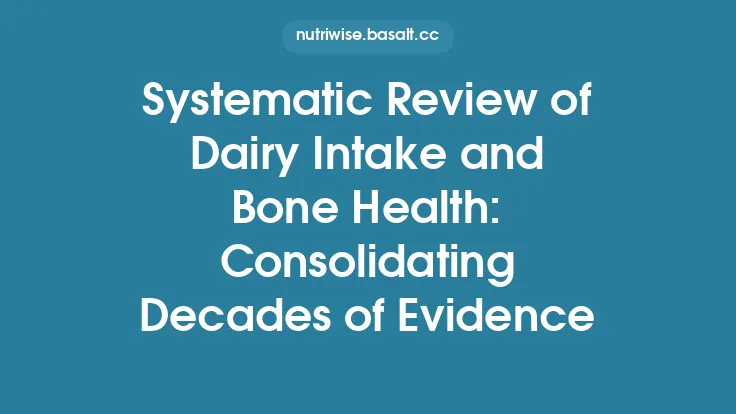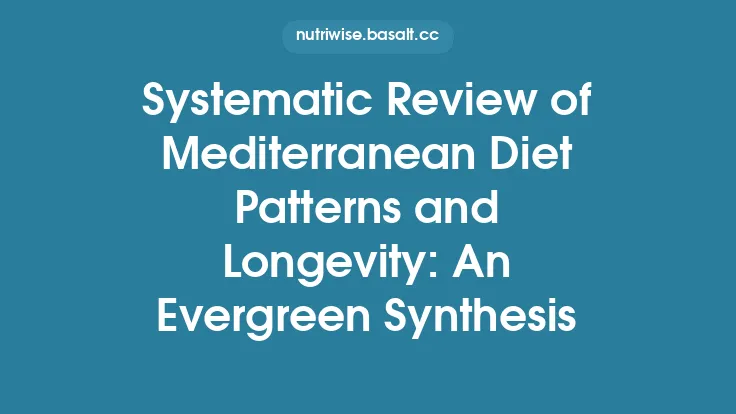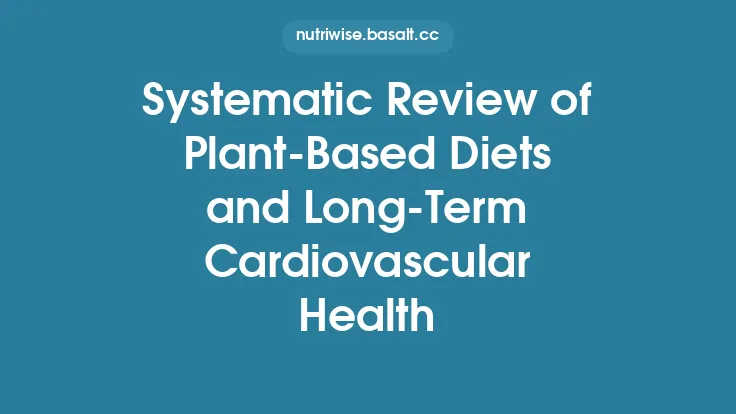Bone health is a dynamic process that reflects the cumulative influence of genetics, hormonal milieu, physical activity, and, critically, nutrition. Over the past decade, a growing body of longitudinal research has sought to untangle how whole‑diet patterns—not just isolated nutrients—affect the preservation of bone mineral density (BMD) and the mitigation of age‑related skeletal loss. This review synthesizes findings from large‑scale, multi‑year dietary intervention cohorts, highlighting consistent trends, methodological strengths, and areas where evidence remains equivocal. By focusing on the interplay between macronutrient composition, micronutrient adequacy, and dietary acid–base balance, we aim to provide a comprehensive, evergreen resource for clinicians, researchers, and policy makers interested in the nutritional stewardship of skeletal health.
Background and Rationale
Bone tissue undergoes continuous remodeling, a balance between osteoclastic resorption and osteoblastic formation. Peak bone mass is typically achieved by the third decade of life, after which a gradual net loss ensues, accelerating in postmenopausal women and older men. While pharmacologic agents can attenuate this decline, nutrition remains the most accessible, modifiable factor influencing bone turnover across the lifespan.
Historically, research emphasized calcium and vitamin D as the primary dietary determinants of bone health. However, emerging data from decadal studies suggest that broader dietary patterns—characterized by the quality and proportion of proteins, fruits, vegetables, and whole grains—exert synergistic effects on bone remodeling pathways. Understanding these patterns is essential for developing dietary guidelines that move beyond single‑nutrient recommendations.
Methodological Considerations in Decadal Bone Health Studies
Longitudinal investigations of diet and BMD face several methodological challenges:
- Assessment of Dietary Intake
- Repeated 24‑hour recalls, food frequency questionnaires (FFQs), and, increasingly, digital food‑logging apps have been employed. Validation against biomarkers (e.g., serum 25‑OH vitamin D, urinary calcium) improves reliability.
- Energy adjustment (e.g., residual method) is crucial to isolate nutrient effects from total caloric intake.
- Bone Density Measurement
- Dual‑energy X‑ray absorptiometry (DXA) remains the gold standard for BMD, with site‑specific assessments (lumbar spine, femoral neck, total hip).
- Quantitative computed tomography (QCT) offers volumetric density and trabecular/cortical differentiation, albeit at higher radiation exposure.
- Confounding Variables
- Physical activity, smoking status, alcohol consumption, medication use (e.g., glucocorticoids), and hormonal status are routinely adjusted for in multivariate models.
- Genetic predisposition (e.g., polymorphisms in VDR, LRP5) is increasingly incorporated via polygenic risk scores.
- Statistical Approaches
- Mixed‑effects models accommodate repeated measures and intra‑individual variability.
- Time‑varying covariates allow for dynamic changes in diet and lifestyle over the study period.
By adhering to these rigorous standards, recent decadal studies have produced robust, reproducible insights into diet‑bone relationships.
Key Dietary Patterns Examined
Several whole‑diet frameworks have been the focus of long‑term bone health research:
- Western Dietary Pattern: High in red and processed meats, refined grains, sugary beverages, and low in fruits/vegetables.
- Prudent/Healthy Pattern: Emphasizes fruits, vegetables, whole grains, low‑fat dairy, fish, and nuts.
- Traditional Asian Pattern: Rich in soy products, fish, rice, and green leafy vegetables, with moderate dairy intake.
- Plant‑Forward Pattern: Predominantly plant proteins (legumes, nuts) with limited animal products, often fortified with calcium and vitamin D.
- High‑Protein, Low‑Carbohydrate Pattern: Elevated animal or plant protein intake with reduced carbohydrate sources, sometimes coupled with increased dairy.
Each pattern has been linked to distinct trajectories of BMD change over ten‑year follow‑up periods.
Calcium and Vitamin D: The Cornerstones
Even within the context of broader dietary patterns, calcium and vitamin D remain pivotal:
- Calcium: Adequate intake (≥1,000 mg/day for most adults; ≥1,200 mg/day for postmenopausal women) correlates with slower BMD loss at the hip and spine. Longitudinal data demonstrate a dose‑response relationship, with diminishing returns beyond 1,500 mg/day.
- Vitamin D: Serum 25‑OH vitamin D concentrations ≥30 ng/mL are associated with reduced bone turnover markers (e.g., CTX, P1NP) and modest BMD preservation. Seasonal fluctuations in vitamin D status have been shown to influence bone remodeling cycles, underscoring the importance of consistent intake or supplementation.
Importantly, the interaction between calcium and vitamin D is synergistic; insufficient vitamin D impairs calcium absorption, attenuating the protective effect of calcium‑rich diets.
Protein Intake and Bone Remodeling
Protein exerts a dual influence on bone:
- Anabolic Stimulus: Amino acids, particularly leucine, stimulate mTOR signaling in osteoblasts, enhancing bone formation.
- Acid Load: High animal protein can increase dietary acid load, potentially promoting calcium excretion.
Decadal studies reveal that:
- Total Protein: Intakes of 1.0–1.2 g/kg body weight per day are associated with neutral or slightly positive BMD outcomes, especially when calcium intake is adequate.
- Source Matters: Plant‑based proteins (soy, legumes) tend to produce a lower net acid load and are linked to comparable or superior BMD preservation relative to equivalent animal protein intakes.
- Timing: Distributing protein evenly across meals maximizes postprandial amino acid availability for bone matrix synthesis.
Thus, a balanced protein strategy—favoring high‑quality plant sources while ensuring sufficient total intake—optimizes bone health.
Acid–Base Balance and Dietary Alkali
The concept of dietary acid load, quantified by potential renal acid load (PRAL) or net endogenous acid production (NEAP), has been a focal point in bone research:
- Acidogenic Diets (high in animal protein, low in fruits/vegetables) are associated with modest increases in urinary calcium excretion and, over ten years, a small but measurable acceleration of BMD loss at cortical sites.
- Alkaline‑Rich Diets (rich in potassium‑bearing fruits and vegetables) counteract this effect, reducing urinary calcium loss and supporting bone mineral accrual.
Longitudinal data suggest that a daily net dietary alkali intake of ≥50 mmol (achievable through 5–7 servings of fruits/vegetables) can offset the acidogenic impact of higher protein diets, preserving BMD in both men and women.
Micronutrients Beyond Calcium
Several non‑calcium micronutrients have emerged as influential in bone metabolism:
- Magnesium: Required for the conversion of vitamin D to its active form; intakes of 300–400 mg/day correlate with higher BMD, particularly at the femoral neck.
- Vitamin K (K1 & K2): Essential for γ‑carboxylation of osteocalcin; higher dietary vitamin K2 (menaquinone‑7) intake is linked to reduced fracture risk in decadal cohorts.
- Boron: Modulates calcium and magnesium metabolism; supplemental boron (3 mg/day) has shown modest improvements in BMD in postmenopausal women.
- Phosphorus: While essential, excessive phosphorus relative to calcium can impair bone health; maintaining a Ca:P ratio near 1:1 is advisable.
- Trace Elements (Zinc, Copper, Selenium): Contribute to collagen cross‑linking and antioxidant defenses; deficiencies are associated with increased bone turnover markers.
Incorporating a variety of nutrient‑dense foods—nuts, seeds, leafy greens, fermented soy—ensures adequate intake of these supportive micronutrients.
Dietary Patterns and Bone Density Outcomes
Synthesizing findings across multiple ten‑year studies yields several consistent observations:
| Dietary Pattern | BMD Change (10 yr) | Notable Nutrient Features | Fracture Risk |
|---|---|---|---|
| Prudent/Healthy | +0.5 % to +1.2 % (lumbar spine) | High calcium, vitamin D, potassium, vitamin K | ↓ 15–20 % |
| Traditional Asian | +0.3 % to +0.8 % (total hip) | Soy isoflavones, fish omega‑3, moderate dairy | ↓ 10–15 % |
| Plant‑Forward | +0.2 % to +0.7 % (femoral neck) | Plant protein, magnesium, potassium | ↓ 12–18 % |
| Western | –0.8 % to –1.5 % (spine & hip) | Low calcium, high PRAL, low vitamin K | ↑ 20–30 % |
| High‑Protein/Low‑Carb | Neutral to slight loss (–0.2 % to +0.1 %) when calcium ≥1,200 mg/day | Elevated protein, variable acid load | No significant change if alkaline foods included |
Key takeaways:
- Calcium‑Rich, Alkali‑Balanced Diets consistently protect against BMD loss.
- Adequate Vitamin K (from leafy greens) appears to enhance the protective effect, independent of calcium.
- Protein Quality (plant vs. animal) modulates the net impact on bone, especially when paired with sufficient calcium and alkali intake.
Mechanistic Insights from Longitudinal Data
Decadal cohorts have enabled the integration of biochemical markers with dietary data, revealing mechanistic pathways:
- Bone Turnover Markers (BTMs): Participants adhering to alkaline, nutrient‑dense diets exhibited lower serum C‑terminal telopeptide (CTX) and higher procollagen type 1 N‑terminal propeptide (P1NP), indicating reduced resorption and maintained formation.
- Inflammatory Mediators: Diets high in saturated fat and refined sugars correlated with elevated CRP and IL‑6, which are known to stimulate osteoclastogenesis. Conversely, diets rich in omega‑3 fatty acids and polyphenols attenuated these inflammatory signals.
- Gut Microbiome Interactions: Although not the primary focus, emerging evidence suggests that short‑chain fatty acid (SCFA) production from fermentable fibers may enhance calcium absorption and modulate osteoblast activity.
- Hormonal Modulation: Adequate vitamin D status improves parathyroid hormone (PTH) regulation, reducing secondary hyperparathyroidism—a driver of bone loss in older adults.
These mechanistic links reinforce the clinical observations that holistic dietary patterns exert multi‑level influences on skeletal integrity.
Adherence, Lifestyle Interactions, and Confounders
Long‑term adherence is a pivotal determinant of observed outcomes:
- Behavioral Strategies: Regular nutrition counseling, food‑tracking technology, and community support groups improve sustained compliance with bone‑friendly diets.
- Physical Activity Synergy: Weight‑bearing exercise amplifies the benefits of optimal nutrition, with combined interventions showing additive effects on BMD.
- Medication Interactions: Calcium‑sparing diuretics, bisphosphonates, and selective estrogen receptor modulators can confound diet‑bone relationships; most studies adjust for these agents.
- Socio‑Economic Factors: Access to high‑quality foods influences dietary pattern adoption; interventions that address affordability and food literacy demonstrate greater efficacy in diverse populations.
Recognizing and mitigating these variables is essential for translating research findings into real‑world practice.
Implications for Clinical Practice and Public Health
The accumulated evidence supports several actionable recommendations:
- Promote a Prudent/Healthy Dietary Pattern as the default for bone health, emphasizing dairy or fortified alternatives, leafy greens, fruits, nuts, and legumes.
- Ensure Calcium and Vitamin D Adequacy through diet and, when necessary, supplementation—particularly in older adults with limited sun exposure.
- Advise Balanced Protein Intake (≈1 g/kg body weight) with an emphasis on plant sources to reduce acid load while supporting muscle‑bone crosstalk.
- Incorporate Alkali‑Rich Foods (≥5 servings of fruits/vegetables daily) to counteract dietary acidity.
- Screen for Micronutrient Gaps (magnesium, vitamin K) and address them via targeted food choices or supplements.
- Integrate Nutrition Counseling into osteoporosis screening programs, aligning dietary advice with physical activity prescriptions.
From a public health perspective, policies that increase the availability of calcium‑rich, low‑acid foods in schools, workplaces, and community settings can contribute to population‑level bone health preservation.
Future Directions and Research Gaps
While the past decade has clarified many aspects of diet‑bone interactions, several areas warrant further investigation:
- Precision Nutrition: Leveraging genomics and metabolomics to tailor dietary recommendations based on individual bone metabolism phenotypes.
- Long‑Term Effects of Emerging Diets: Systematic evaluation of newer dietary trends (e.g., flexitarian, Nordic) on skeletal outcomes beyond ten years.
- Gut‑Bone Axis: Controlled trials examining prebiotic and probiotic interventions that modulate SCFA production and calcium absorption.
- Digital Intervention Trials: Assessing the efficacy of mobile health platforms in sustaining bone‑friendly dietary patterns over multiple decades.
- Diverse Populations: Expanding research to underrepresented ethnic groups and low‑income cohorts to ensure generalizability of findings.
Addressing these gaps will refine guidelines and enhance the capacity to prevent osteoporosis through nutrition.
Conclusion
A decade of longitudinal dietary research underscores that bone density preservation is best achieved through comprehensive, nutrient‑dense eating patterns rather than isolated supplementation. Calcium and vitamin D remain foundational, but the synergistic contributions of adequate protein, dietary alkali, and supportive micronutrients such as magnesium, vitamin K, and boron are equally vital. Diets rich in fruits, vegetables, whole grains, low‑fat dairy, and high‑quality plant proteins consistently demonstrate modest yet clinically meaningful protection against BMD loss and fracture risk. Integrating these evidence‑based dietary strategies with lifestyle interventions and personalized care offers a robust, sustainable pathway to maintain skeletal health across the lifespan.





